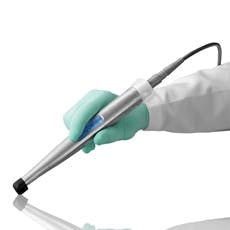Spectra provides color, numerical indications of the extent of decay
By Maria Perno Goldie, RDH, MS
As preventive oral health professionals, we have the responsibility to use scientific evidence in the decision-making process of treating our patients. Clinical evaluation of soft and hard tissues is a part of the dental hygiene process of care. Dental decay and the infectious caries process is one of the most prevalent diseases in humans.(1) Dental caries is a multifactorial chronic disease that begins with microbiological changes within the complex biofilm. It is the result of an ecological disturbance of the established equilibrium between tooth minerals and oral microbial biofilm.(2)Detecting potential carious lesions is critical to either remineralize or treat the existing lesion.(3) When using conventional clinical and radiographic methods, practitioners will detect only half of the carious lesions present and could easily misclassify sound surfaces as decayed.(4) The use of radiographs is recommended as part of the routine examination, but about 30 percent to 40 percent of mineral loss needs to take place before the lesion is visible radiographically. It may take up to nine months or longer before demineralization appears on a radiograph.(5)Explorers have very low sensitivity for caries detection and provide virtually no diagnostic feedback.(6) Explorers may in reality cause damage by breaking enamel rods and causing an iatrogenic cavitation when forced into an incipient carious lesion.(6) Non-invasive caries detection aids can help eliminate the guesswork in detecting and diagnosing tooth decay and enhance case acceptance through better patient education. Spectra, recently awarded the Pride Institute's coveted "Best of Class Technology Award" for a second consecutive year, is a caries detection aid providing both color and numerical indications of the extent of the decay.
As preventive oral health professionals, we have the responsibility to use scientific evidence in the decision-making process of treating our patients. Clinical evaluation of soft and hard tissues is a part of the dental hygiene process of care. Dental decay and the infectious caries process is one of the most prevalent diseases in humans.(1) Dental caries is a multifactorial chronic disease that begins with microbiological changes within the complex biofilm. It is the result of an ecological disturbance of the established equilibrium between tooth minerals and oral microbial biofilm.(2)Detecting potential carious lesions is critical to either remineralize or treat the existing lesion.(3) When using conventional clinical and radiographic methods, practitioners will detect only half of the carious lesions present and could easily misclassify sound surfaces as decayed.(4) The use of radiographs is recommended as part of the routine examination, but about 30 percent to 40 percent of mineral loss needs to take place before the lesion is visible radiographically. It may take up to nine months or longer before demineralization appears on a radiograph.(5)Explorers have very low sensitivity for caries detection and provide virtually no diagnostic feedback.(6) Explorers may in reality cause damage by breaking enamel rods and causing an iatrogenic cavitation when forced into an incipient carious lesion.(6) Non-invasive caries detection aids can help eliminate the guesswork in detecting and diagnosing tooth decay and enhance case acceptance through better patient education. Spectra, recently awarded the Pride Institute's coveted "Best of Class Technology Award" for a second consecutive year, is a caries detection aid providing both color and numerical indications of the extent of the decay.
The key features are: fluorescence technology indicates extent of decay with color and numerical readings; eliminates the guesswork for early caries detection; information-rich images enhance case acceptance; early detection means more restoration and less excavation; can be used during caries removal process to ensure all carious dentin is removed; allows you to store and compare images over time to track the effect of your treatment; can be used to detect Fractured Tooth Syndrome, plaque and caries; works with most patient management software; connects to computer with USB cable, and weighs 2.1 ounces.
Spectra uses fluorescence technology to enable reliable tooth-by-tooth detection of fissure caries and caries on smooth surfaces that are too small to be detected by an radiograph. Special light intensity LEDs project safe, high energy violet-blue light onto the tooth surface. This violet-blue light stimulates metabolites of cariogenic bacteria, porphyrins, to appear red when viewed on a monitor, while healthy enamel fluoresces green. After capturing the image within your existing imaging software, the extent of the decay will be interpolated and indicated in two ways: the color will be either blue, red, orange or yellow; a numerical indicator between 0 and 5.0 will be shown. It can be used during the restorative phase to verify that all caries have been removed, and can detect decay hidden between the margins of existing composite and amalgam restorations. It is FDA cleared and is safe to use on both children and adults. The handpiece connects to your computer network via a USB cable.
For more information, visit the website.(7) References
1. Berg JH. Dental caries detection and caries management by risk assessment. J Esthet Restor Dent. 2007; 19(1): 49-55. 2. Beneduce, C. Use of the explorer for caries detection. ACCESS, Aug 1, 2010, ISSN: 1050-0758.3. Diagnosis and Management of Dental Caries Throughout Life. NIH Consensus Statement Online 2001 March 26-28; [cited 2012, May 16]; 18(1): 1-24.4. Selwitz RH, Ismail AI, Pitts NB. Dental caries. Lancet. 2007; 369(9555): 51-9.5. Choo-Smith LP, Dong CCS, Cleghorn B, Hewko M. Shedding new light on early caries detection. JCDA 2008; 74(10): 913-8.6. Neuhaus KW, Ellwood R, Lussi A, Pitts NB. Traditional lesion detection aids. Monogr Oral Sci. 2009; 21:42-51. Epub 2009 Jun. 3.7. www.airtechniques.com/products/spectra-caries-detection-aid.html. Accessed May 16, 2012.
1. Berg JH. Dental caries detection and caries management by risk assessment. J Esthet Restor Dent. 2007; 19(1): 49-55. 2. Beneduce, C. Use of the explorer for caries detection. ACCESS, Aug 1, 2010, ISSN: 1050-0758.3. Diagnosis and Management of Dental Caries Throughout Life. NIH Consensus Statement Online 2001 March 26-28; [cited 2012, May 16]; 18(1): 1-24.4. Selwitz RH, Ismail AI, Pitts NB. Dental caries. Lancet. 2007; 369(9555): 51-9.5. Choo-Smith LP, Dong CCS, Cleghorn B, Hewko M. Shedding new light on early caries detection. JCDA 2008; 74(10): 913-8.6. Neuhaus KW, Ellwood R, Lussi A, Pitts NB. Traditional lesion detection aids. Monogr Oral Sci. 2009; 21:42-51. Epub 2009 Jun. 3.7. www.airtechniques.com/products/spectra-caries-detection-aid.html. Accessed May 16, 2012.
Maria Perno Goldie, RDH, MS
To read previous articles in RDH eVillage FOCUS written by Maria Perno Goldie, go to articles.


